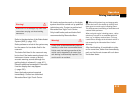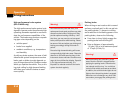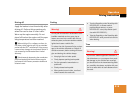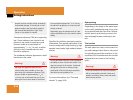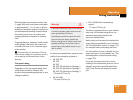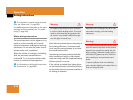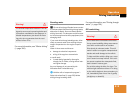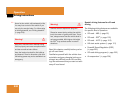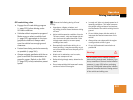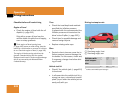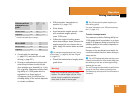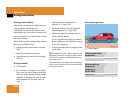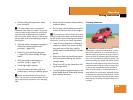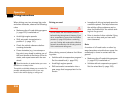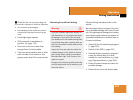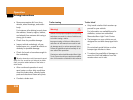
321
Operation
Driving instructions
Off-road driving rules
ț Engage the off-road driving program
(
୴ page 253) before driving under
off-road conditions.
ț Vehicles with air suspension program*:
Make sure you select a vehicle level
(
୴ page 255) appropriate to the topo-
graphical conditions. Always make
sure the vehicle has enough ground
clearance.
ț Fasten items being carried as securely
as possible (
୴ page 266).
ț Always navigate gradients with the en-
gine on and with the transmission en-
gaged in a gear. Switch on the DSR
(
୴ page 250) to help maintain a preset
speed.
!
Observe the following during off-road
driving:
ț Keep doors, tailgate, windows, and
tilt/sliding sunroof closed whenever driving
off-road.
ț Adjust vehicle speed to condition of terrain.
The more uneven, rutty and steeper the ter-
rain, the lower the speed should be. Drive
through water slowly at an even speed,
avoiding a bow wave.
ț Be especially careful when driving in un-
known territory. It may be necessary to get
out of the vehicle and scout the path you in-
tend to take.
ț Watch out for obstacles, such as rocks,
holes, tree stumps and ruts.
ț Before driving through water, determine its
depth.
ț Do not stop vehicle while immersed in water,
and do not shut off the engine.
ț In sandy soil, drive at a steady speed as al-
lowed by conditions. This helps overcome
the vehicle rolling resistance and reduces
the likelihood of the vehicle sinking into the
ground.
ț Do not initiate jumps with the vehicle. It
interrupts the forward momentum of the
vehicle.
ț Always drive onto slopes with the engine
running and the vehicle in gear.
ț Do not shift automatic transmission to
position N.
Warning! G
Do not reduce the tire inflation pressure
before driving through sand. However, if you
do so, remember to correct the tire inflation
pressure (
୴ page 359) before continuing
your trip. Driving with reduced tire inflation
pressure increases the risk of losing control
of the vehicle and rolling over.



